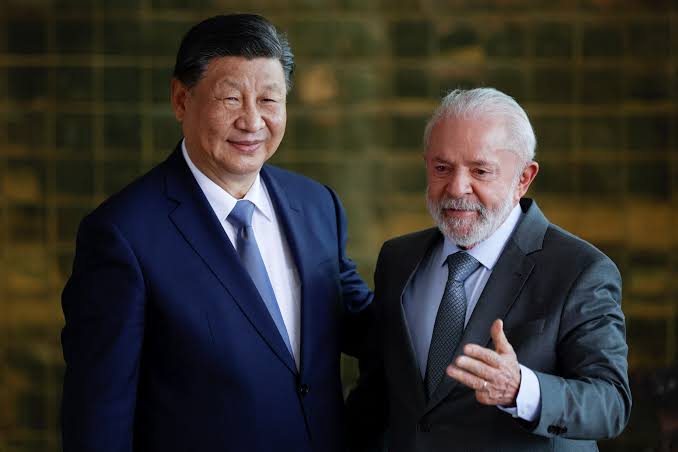Brazilian President Luiz Inacio Lula da Silva is in Beijing this week to meet with Chinese President Xi Jinping, aiming to strengthen ties between the two nations. Lula hopes to capitalize on trade tensions resulting from former U.S. President Donald Trump’s policies to increase Brazilian exports of grains, metals, and meat to China.
Officials from Brazil, a major commodities exporter, anticipate that Lula’s visit will result in over a dozen agreements and new investment announcements in sectors ranging from agriculture to railways. Brazil aims to fill the void left by costlier U.S. goods, which have been subject to tariffs imposed by Beijing in response to tariffs enacted by Trump.
“It opens an opportunity, as the exports from the United States become unfeasible at this moment due to 145% tariffs,” Luis Rua, who oversees foreign trade for Brazil’s Ministry of Agriculture, told Reuters.
Rua stated that Brazil intends to expand its exports of sorghum, pork, and chicken to China, thereby increasing its market share. He noted that the U.S. currently supplies approximately 45% of China’s sorghum imports, 30% of its chicken, and 16% of its pork.
This four-day visit marks Lula’s third in-person meeting with Xi since assuming office in 2023. Other Latin American leaders, including Chile’s President Gabriel Boric and Colombia’s Gustavo Petro, have also visited Beijing for meetings between Chinese officials and the Community of Latin American and Caribbean States (CELAC).
Read more: Hungary’s Ruling Party Introduced a Bill to Ban Pride Marches.
The Lula-Xi summit builds on the enhanced diplomatic relations established during a meeting in Brazil last November, where the leaders signed over 40 agreements across various sectors, including infrastructure, energy, and agribusiness.
Brazilian Minister of Transportation Renan Filho told Reuters that Chinese investors have expressed interest in several railway projects in Brazil, including those connecting agricultural and mining regions to ports such as Barcarena, Açu, and the recently inaugurated Chinese-operated port in Chancay, Peru.
“We will sign all projects that have road and rail synergy with the potential to increase exports to China, especially agriculture, but also other things, such as mining,” Filho said.
While acknowledging that these plans have been presented to Chinese investors previously, Filho believes that the relationship between the two countries has matured sufficiently for these projects to progress.
He added that a more solid agreement regarding the nature of their relationship was reached last year, following years of unsuccessful attempts by Chinese diplomats to persuade Brazil to join the Belt and Road Initiative, China’s global infrastructure program.
Instead, in November, the two countries agreed to identify “synergies” between China’s plans and Brazil’s own development programs.
A Brazilian diplomat, speaking anonymously to Reuters, stated that this week’s visit to Beijing is focused on adding concrete projects and investments to these “synergies.”
China is Brazil’s largest export market and has been a significant foreign investor in Latin America, although its investment approach has become more cautious recently. According to a survey by the Brazil-China Business Council, Chinese investments in Brazil totaled $1.73 billion in 2023, representing a 33% increase compared to the previous year, but still the second-lowest figure since 2007.
Tulio Cariello, the council’s director of research, noted that transportation, particularly rail, has significant potential to attract Chinese investments, although past projects have been hindered by bureaucratic and budgetary challenges.
“I see that there is a lot of Chinese interest,” Cariello said, adding that the two countries are now better equipped to overcome these obstacles. “There is now much more comprehensive knowledge about Brazil in China than there was before.”





